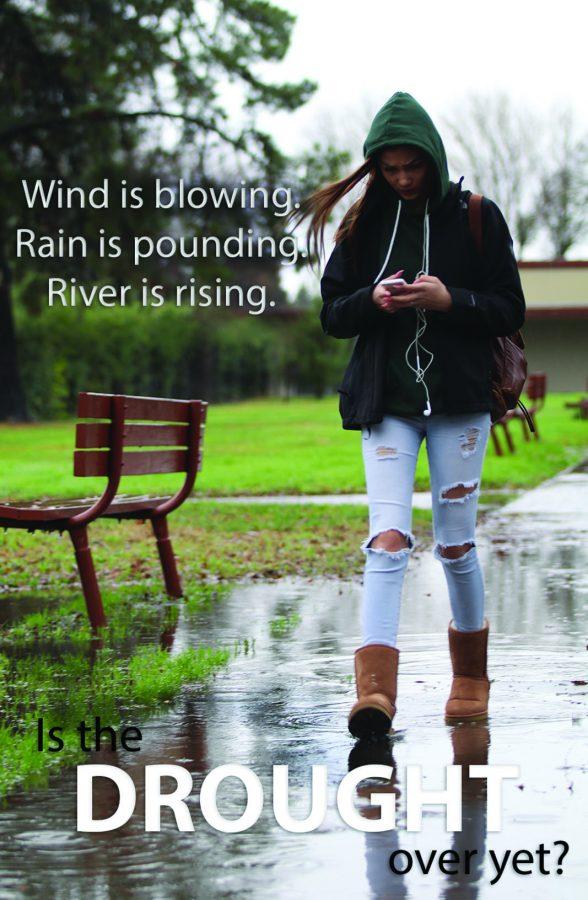Problems will persist despite the recent rains
Freshman Catherine Gaines gets caught in the rain when walking from her third period to her fourth. Like some students, Gaines feels that the rain can cause issues getting between classes but sees it as a necessary evil.
As storms continue to hit the West Coast, one question floods into the minds of Californians: is the drought over? The short answer is no.
“The wet season is off to a good start,” said biology teacher Marcus Sherman, “but this is only the beginning.”
Although there has been plenty of rain, there are other factors that determine whether California stays under emergency drought rules like snowpack, reservoir and groundwater levels.
Because of these factors, according to Alex Breitler, environmental reporter for the Stockton Record, “it is very difficult to state that the drought is over.”
Reservoir storage and most especially groundwater levels are critical issues for lawmakers and those that depend on water. During a drought, reservoir levels decrease, causing farmers and water providers to resort to pumping water from underground. Because users from across the state – especially those in southern California – depend on reservoir water, so much groundwater has been used that it’s become detrimental.
“Groundwater can recharge, but as more is taken, the ‘tank’ gets smaller,” Sherman said. There is gradual recovery occurring. When periods of rain are followed by dry periods, water is able to seep back into the ground. National Public Radio has reported on farmers who are using this tactic to prevent sinkage caused by overdraft.
With recent rain, current reservoir measurements from key sources like New Melones are also showing promise. According to data collected by the California Data Exchange Center, New Melones contains 967,925 acre feet of water, compared to 372,486 acre feet from this time last year. Data from all reservoirs across the state reflect similar improvements in water levels.
Farmers, however, are always concerned with the cost of using water to irrigate their fields and the constant state of not knowing if there will be crop to harvest. English teacher Martin Bagnasco, whose family grew almonds, described farming as “a gamble. Some years are good and some years, not so much,” he said.
Fellow english teacher Randall Pombo also has family members who are farmers and ranchers. Growing up on a farm in Tracy, he recalls how simple it was to pull water from the canals. “Now the demand is so high,” Pombo explains, and the state also has to worry about the rest of the population.
For the average Californian, however, there is one main concern: the cost. “People care when they pay,” Sherman said. In the past several years, Californians haven’t been paying the true cost of water. Because the drought created a water deficiency, along with conservation efforts by the state and citizens, water providers couldn’t charge as much because customers haven’t been using that much.
“State officials have eliminated required saving percentages,” Breitler said. “This means water providers can start charging more as citizens use more.” In order to counteract the loss in revenue due to decreased consumption, Stockton officials have approved an 18 percent water rate increase.
Despite the hard truth of the drought, Breitler affirms that “Stockton isn’t in bad shape. We have many sources of water that put the city in a good spot.” Not only does Stockton draw water from New Hogan and New Melones reservoirs, but Stocktonians now receive water straight from the Delta through the drinking water plant on Empire Tract.
“It’s important to maintain conservation habits,” Breitler said. Even though the drought’s effects are lessening, it’s still vital that Californians continue to cut back on water usage. These measures, especially when the wet season doesn’t bring enough rain to sustain demand, significantly soften the blow of future droughts.















